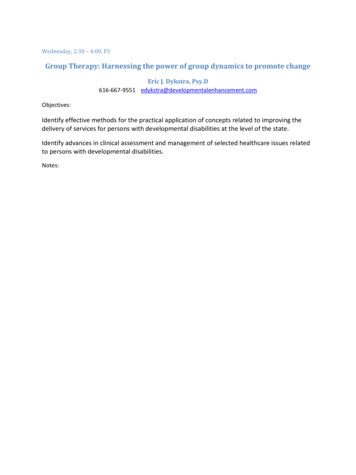
Transcription
Wednesday, 2:30 – 4:00, F3Group Therapy: Harnessing the power of group dynamics to promote changeEric J. Dykstra, Psy.D616-667-9551 entify effective methods for the practical application of concepts related to improving thedelivery of services for persons with developmental disabilities at the level of the state.Identify advances in clinical assessment and management of selected healthcare issues relatedto persons with developmental disabilities.Notes:
WELCOME!Group Therapy:Harnessing the power of group dynamics to promote change Brief Discussion:– Your Experiences with GroupsEric J. Dykstra, Psy.DDevelopmental Enhancement, PLCOutline of Presentation General Group Principles– The Group Leader– Group Development– Group Dynamics Group PsychotherapyGROUPS Collections of Individuals– Connected in some way– Together for some purpose– Situated in some manner– History and Purpose of Group Therapy– Leaders in Group Therapy– Application of Principles to Therapy Nuts and BoltsGroup Leadership Formal vs. Informal Leadership Functions of Leader– Creator & Sustainer establish & facilitate growth– Starter & Summarizer– Partner, Teacher, and GuideGroup Leadership Presence– Authentically engaging with others Present-focusedReaching OutExpressivenessSelf-Knowing(Halpern & Lubar, 2003)1
Group Development: PhasesGroup Dynamics Groups as a Social Microcosm Forming (getting acquainted)Storming (struggling forward)Norming (becoming interpersonal)Performing (working together)Transferring (generalizing)Group Dynamics Natural Hierarchies– Leaders and Followers,– “Pecking Order”– Here-And-Now Interactions– Real-Time Problem Solving– In-Vivo Relationship BuildingGroups Overlap between group psychotherapy andother groups, teams, and other collections ofindividuals Roles– Interpersonal Patterns– Situational PatternsHistory of Group Therapy:Leaders Joseph H. Pratt – MD working with patients with TB. Foundthe social support was vital to understanding, teaching, andinspiring Trigant Burrow – psychoanalyst who wrote extensively atbeginning of 20th century about the healing social dynamicsthat were only present with the help of a group. Wilfred Bion – British psychoanalyst that wrote extensively ongroups and group processes in mid-1900s, involved inTavistock Institute Irvin Yalom – popularized theory and practice of grouppsychotherapy. Psychodynamically rooted, but veryexistential/humanistic in practice. Carl Rogers – Encounter Groups, leader of humanisticmovementHistory of Group Therapy Movement from psychoanalyticpsychotherapy to psychoeducation, skillstraining, and support groups– E.g. AA Movement, Anger Management, DBT,Social Skills Training, Depression Support Groups . . . . . the list goes on and on(Ettin, 1999; Rogers, 1970; Yalom 2005)2
Yalom:Yalom Landmark Text:– Theory and Practice of Group Psychotherapy (5editions) Provides a comprehensive perspective on a wide rangeof topics related to groups – especially relationallyfocused process groupsPurpose and Function of Groups UniversalityAltruismInstillation of hopeImparting informationCorrectiverecapitulation of theprimary familyexperience Development ofsocializing techniques Imitative behavior Cohesiveness Existential factors Catharsis Interpersonal learning Self-understanding(Yalom, 2005)Types of Therapy Groups Psychodynamic groups– Process oriented, long term, “re-doing relationships” Support groups– Minimally structured or agenda-focused Problem-solving groups– Focus on teaching one particular set of skills or solving onetype of issue (e.g. Anger Management, Social Skills) Psychoeducational groups– “Learning About” (e.g. Parenting Groups)Purpose of Group Therapy:Clinical Perspective Provide Opportunity to Learn Provide Opportunity to Grow Provide Opportunity to Live Integrative or Multi-faceted Groups– Include components of some or all of the above (e.g. DBT(Linehan, 1993), other current group approaches)Purpose of Group Therapy:Administrative Perspective Provide Services thatare Needed Provide ServicesEffectively Provide ServicesResponsiblyGroup Therapy with Individualswith ID/DD & MH Why Group Therapy?– All of the benefits above, plus Greater need for social networking Such frequent issues with interpersonal skills3
Group Therapy with Individualswith ID/DD & MH Adjustments– Language/Vocabulary– Repetition– Teaching Styles/Methods– Structure (length, frequency, etc.)Group Therapist Tasks Culture Building– The WHAT Model-Setting Participant– The HOW Other ConsiderationsAttwood, 2007, Bütz, Bowling, & Bliss, 2000, Hurley et. al., 1996 Pfadt, 2001The Whats and Hows Establish Safety, Honesty, Trust Demonstrate Vulnerability and Balance Be the Role Model, Motivator, Facilitator,Coach, Teacher, and Healer Note: these are all dynamic processes that aresituationally influencedGroup Therapist Tasks:Setting the Stage Group TopicsGroup FormatGroup Size and CharacteristicsEnvironmental ConsiderationsGroup RulesGroup ContractGroup Therapist Tasks:Primary Roles Create and Maintain Rules Norms Expectations Ensure Survival Police, Firefighter, EMT, Boss,Superhero Mom, Dad,Ways to Develop Groups Check-ins– Emotion & Reason for Emotion– When/Why have you felt lately– Success over past week– Challenge over past week– Did I meet my goal(s)4
Ways to Develop Groups:Icebreaker Activities Sentence Completion– Superpowers– Favorite (games, animals, movies, etc.)– Personal Characteristics– I need/want Ways to Develop Groups:Cohesion Exercises Each person share something that they havelearned/that has touched them Values Sharing (1 week to live, desert island,tombstone, etc.) Problem-solving activities– Human Knot– ‘Puzzles’– Etc. Personal Bingo/Scavenger Hunt Have You Ever/Do You Have On and on and on Nuts and Bolts How To Pick MembersWhere to MeetWhat to Start WithGroup RulesFood?!?CommitmentDifficult Characteristics What makes them difficult?– Difficult to sit with– Difficult to like– Difficult to understand– Difficult to help– Difficult to treatDifficult Dynamics DependencyMonopolizingDominatingAutomatic TalkingRemaining SilentParticipating butBoring Help-RejectingComplaining Remaining the VictimBeing FragileNarcissismBlack-and-WhiteThinking Entitlement andDemanding Over-Disclosing OverthrowingDifficult Dynamics These situations often present the greatestopportunity for growth These are the very dynamics that arepreventing effective interpersonal relating ineveryday life They are not reasons to terminate treatment they ARE the reasons for treatment5
Difficult Dynamics andLeadership Presence Stay present-focused and use theopportunities that present themselves Use the group dynamics to help addressindividual patterns Change will happen through the processGroup Therapist Tools Self-disclosureUse of peer-pressureAuthorityThe Moment Attwood, T. (2007). The Complete Guide to Asperger’s Syndrome. Philadelphia: JessicaKingsley Publishers.Blanchard, K., Zigarmi, P., & Zigarmi, D. (2000). Leadership and the One Minute Manager.New York: HarperCollins Business.Bütz, M. R., Bowling, J. B., & Bliss, C. A. (2000). Psychotherapy with the mentally retarded: Areview of the literature and the implications. Professional Psychology: Research and Practice,31(1), 42-47.Ettin, M.F. (1999). Foundations and Applications of Group Psychotherapy. Philadelphia:Jessica Kingsley Publishers.Halpern, B.L., & Lubar, K. (2003). Leadership Presence. New York: Gotham BooksHurley, A. D., Pfadt, A., Tomasulo, D., & Gardner, W. I. (1996). Counseling and psychotherapy.In J. W. Jacobson & J. A. Mulick, Manual of Diagnosis and Professional Practice in MentalRetardation. Washington, DC: American Psychological Association.Linehan, M. M. (1993). Cognitive-Behavioral Treatment of Borderline Personality Disorder.New York: Guilford.Pfadt, A. (1991). Group psychotherapy with mentally retarded adults: Issues related todesign, implementation, and evaluation. Research in Developmental Disabilities, 12, 261-285.Rogers, C. (1970). Encounter Groups. New York: Harper and RowYalom, I. (2005). Theory and Practice of Group Psychotherapy (5th Ed.). New York: Basic BooksGroup Resources Books– Theory and Practice of Group Psychotherapy (Yalom)– Basics of Group Psychotherapy (Bernard & MacKenzie) Internet– http://www.apa49.org– http://www.aaswg.org/– http://www.group-psychotherapy.com/– http://therapyresourcesinc.com/– http://www.wilderdom.com– http://www.princeton.edu/ oa/manual– http://facultystaff.richmond.edu/ dforsyth/gd/– http://www.community4me.com/Resources.html– http://human-nature.com/rmyoung/papers/References Note: no guarantee is made to quality of resources available on any website.6
Group Therapy: Harnessing the power of group dynamics to promote change Eric J. Dykstra, Psy.D . Yalom 2005) History of Group Therapy Movement from psychoanalytic psychotherapy to psychoeducation, skills training, and support groups -E.g. AA Movement, Anger Management, DBT, Social Skills Training, Depression Support Groups .










